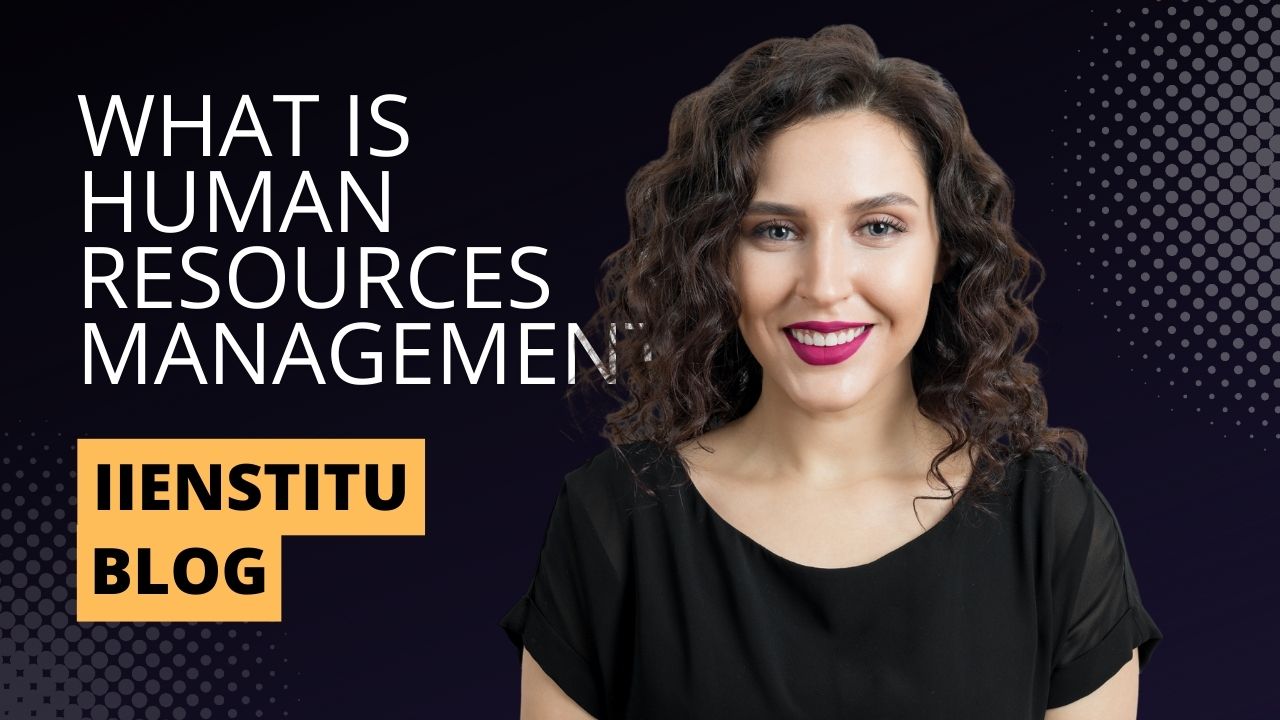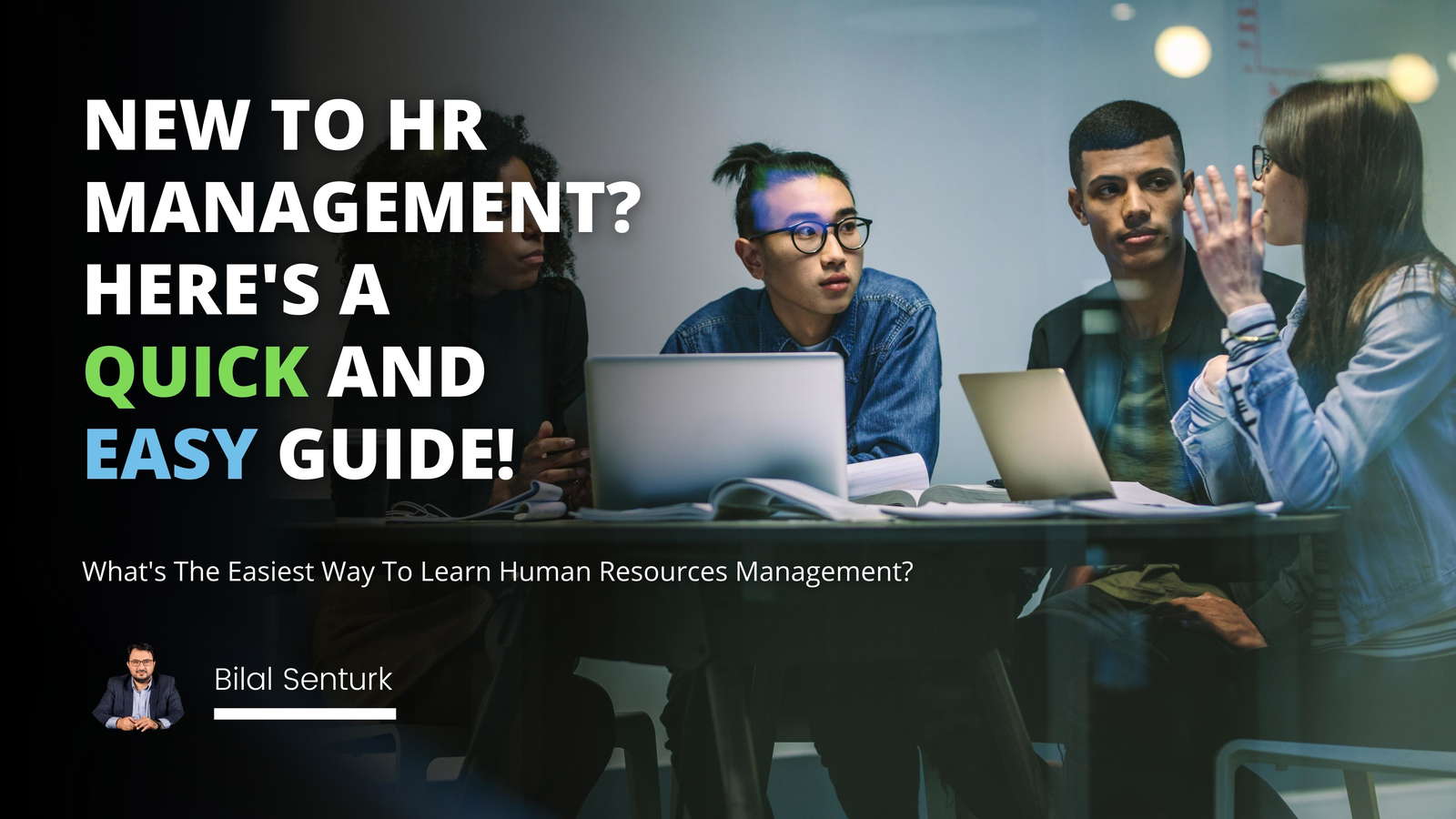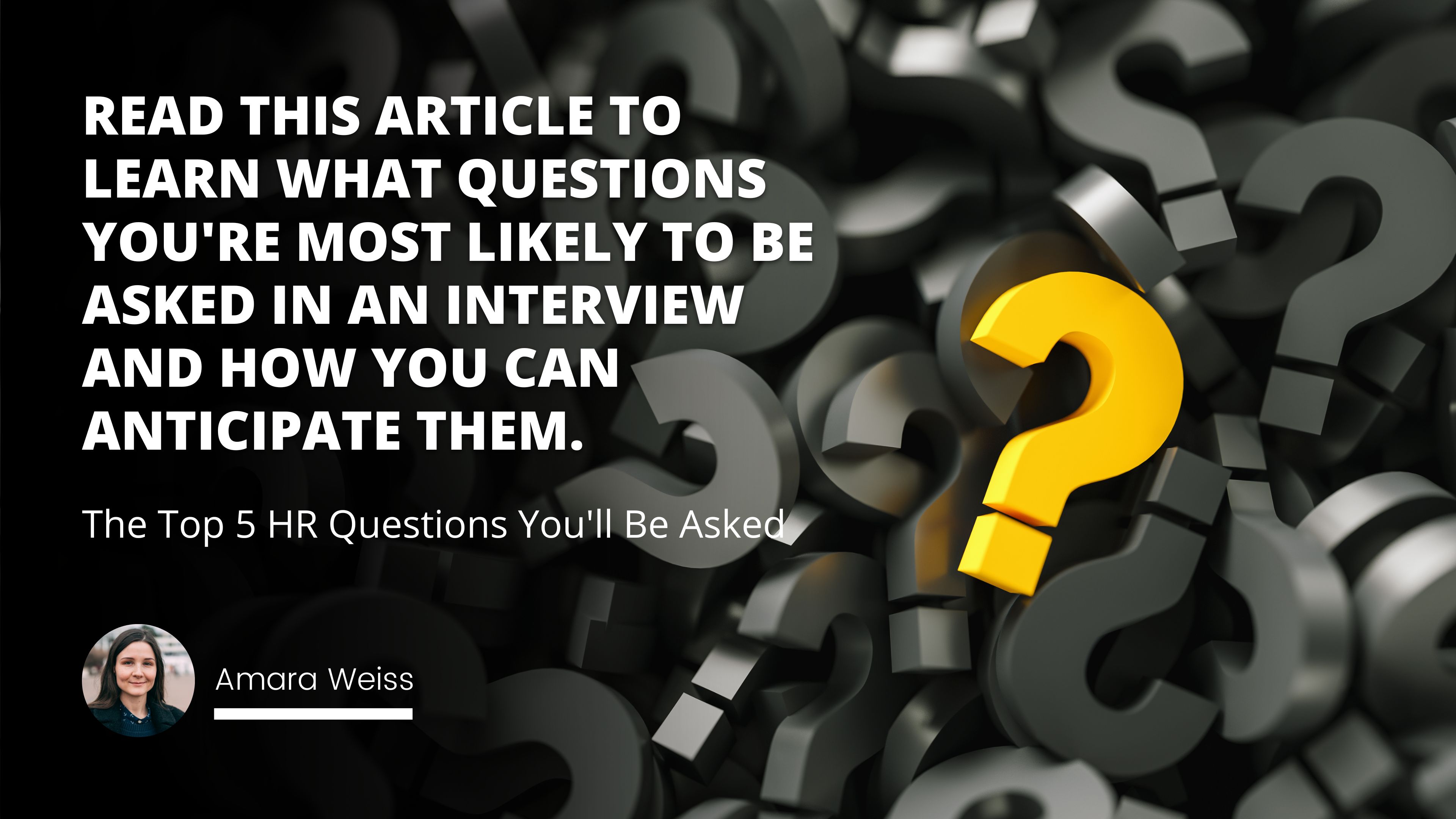
Are you preparing for an interview in the Human Resources (HR) field? It can be a nerve-wracking experience, especially if you don’t know what to expect. To help ease your anxiety and give you the best chance of success, we’ve compiled five of the most common HR questions that employers ask during interviews.
We’ll explain why each question is important and how to answer it effectively. By understanding why these questions are asked and preparing for them beforehand, you'll have greater confidence when it comes time for your big moment! So let's dive into the top five HR interview questions now!
1. What are your strengths and weaknesses?
One of the most common questions asked in a human resources interview is what are your strengths and weaknesses. This question allows employers to gauge how self-aware you are and whether or not you have an understanding of why certain skills might be beneficial for the role. It's important to answer this question honestly, but also focus on highlighting why your strengths make you well-suited for the job at hand.
Additionally, it's wise to discuss any weaknesses in terms of how they can be improved upon with further training or development. By addressing both sides of this question thoughtfully, you can demonstrate that you understand why it matters and show why hiring managers should select you as their top candidate!
2. Why are you interested in this position/company?
Another common question asked in an HR interview is why you're interested in the role or company. This question gives hiring managers insight into how passionate you are about the job itself, as well as why your skillset makes you a great fit for the team. When answering this question, it's important to focus on why you believe your skills can uniquely contribute to the success of the organization.
Additionally, citing any personal connections or experiences that make you particularly drawn to the opportunity is a great way to demonstrate why you should be chosen over other applicants!
3. How would you describe yourself and your work style/philosophy?
This question is meant to assess whether or not you understand why your skills and approach to work make you a valuable asset to the team. It's important to discuss your personality traits honestly, as well as why they make you an ideal fit for the role.
Additionally, it's wise to cite any specific experiences that have shaped your work style or philosophy and why they're especially relevant for the job at hand. By going into depth about why your approach makes you a great candidate, employers will be more likely to recognize why hiring you is the best choice!
4. What can you bring to this position/company that is unique or valuable?
In addition to assessing why your skills make you well-suited for the job, employers also want to know what other qualities and experiences you can bring to the table. This question helps employers gauge why you're more qualified than your fellow applicants, so it's important to cite any relevant experiences or successes that make you stand out from the crowd.
Additionally, if there are any unique skills or qualities that set you apart from others and why they're beneficial for the role, it's wise to discuss those in detail as well!
5. Tell me about a time when you had to deal with a difficult situation at work.
Finally, employers often ask this question as a way of gauging how you handle stress and challenging situations on the job. It's important to be honest about any difficult situation that you've faced and why it was such a challenge for you.
Additionally, it's wise to cite why you chose the solution that you did and why it was ultimately successful. By discussing your approach thoughtfully and why it was effective, employers will be confident in why they should choose you as their top candidate!
By understanding why HR interview questions are asked and preparing for them ahead of time, you can have greater confidence when it comes time for your big moment. With thoughtful answers to each question, you can demonstrate why hiring managers should select you as their top choice! Best of luck on your upcoming HR interview!
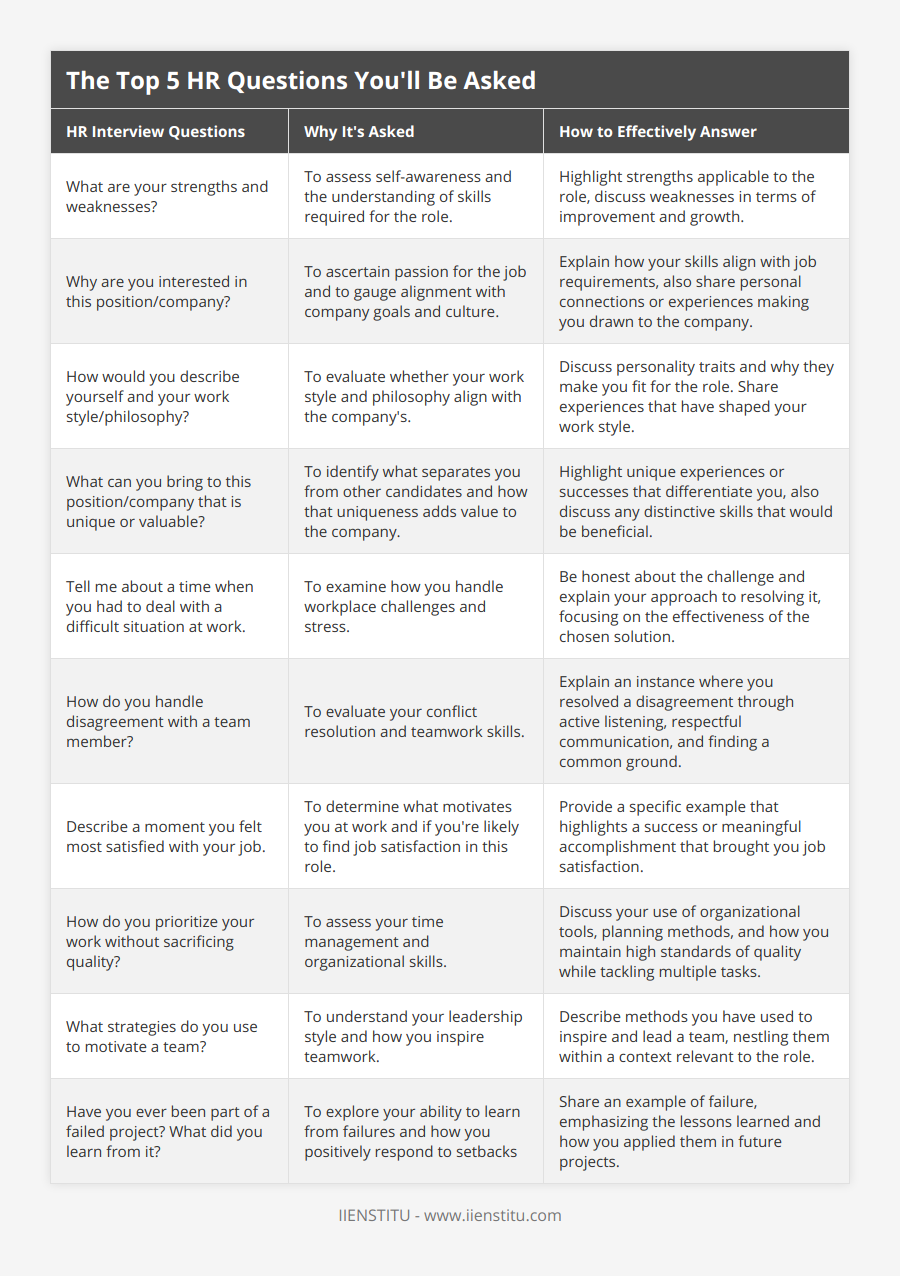
Frequently Asked Questions
Why are Human Resources Interview Questions asked?
Human Resources interview questions are asked to assess why a candidate is the best fit for the job in question. Employers use these questions to gauge why their skills, experience and personality make them an ideal fit for the position. Additionally, HR interview questions help employers understand how candidates think on their feet and why they would be a great fit for their team. By understanding why these questions are important and preparing ahead of time, you can ensure that you have confident answers ready when it matters most!
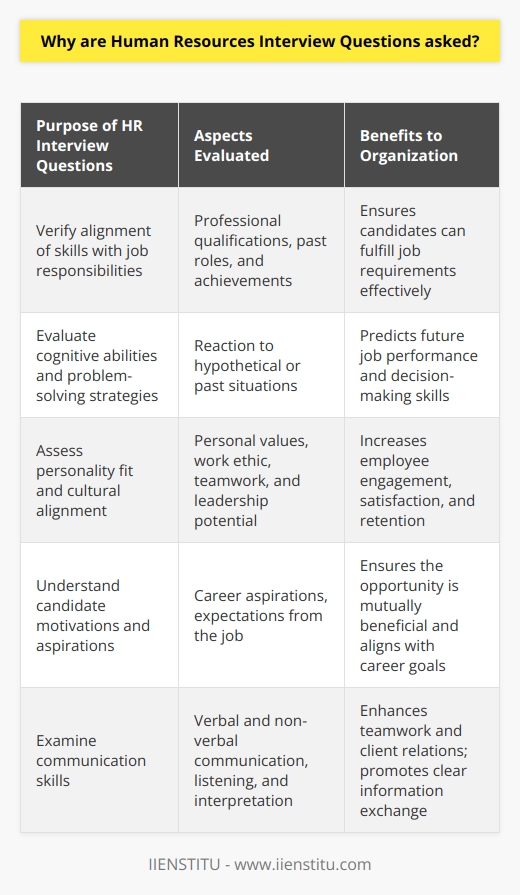
What strategies can I use to prepare for an HR interview?
Preparation is key to success in any HR interview. It's important to research the company and job in order to understand why your skills, experience and personality make you the best fit for the role. Additionally, practice answering potential questions ahead of time so you know exactly how you want to respond in a professional yet personal manner. Finally, make sure that you arrive with extra copies of your resume, cover letter and/or portfolio so that employers can easily access it during or after the interview. By taking these steps before an HR interview, employers will be more likely to recognize why hiring you is ultimately their best choice!

What is the goal of Human Resources interview questions?
The primary goal of a Human Resources (HR) interview is for employers to assess why a candidate has the skills, experience and personality that make them an ideal fit for a certain role. By asking targeted questions, HR professionals can gain more insight into how candidates think on their feet and why they would make an excellent addition to the team. Additionally, interviewing is an important tool to help employers gauge why one candidate may have distinct advantages over another. By understanding why these questions are asked, you can feel confident in why you are the best choice when it's time for your big moment!
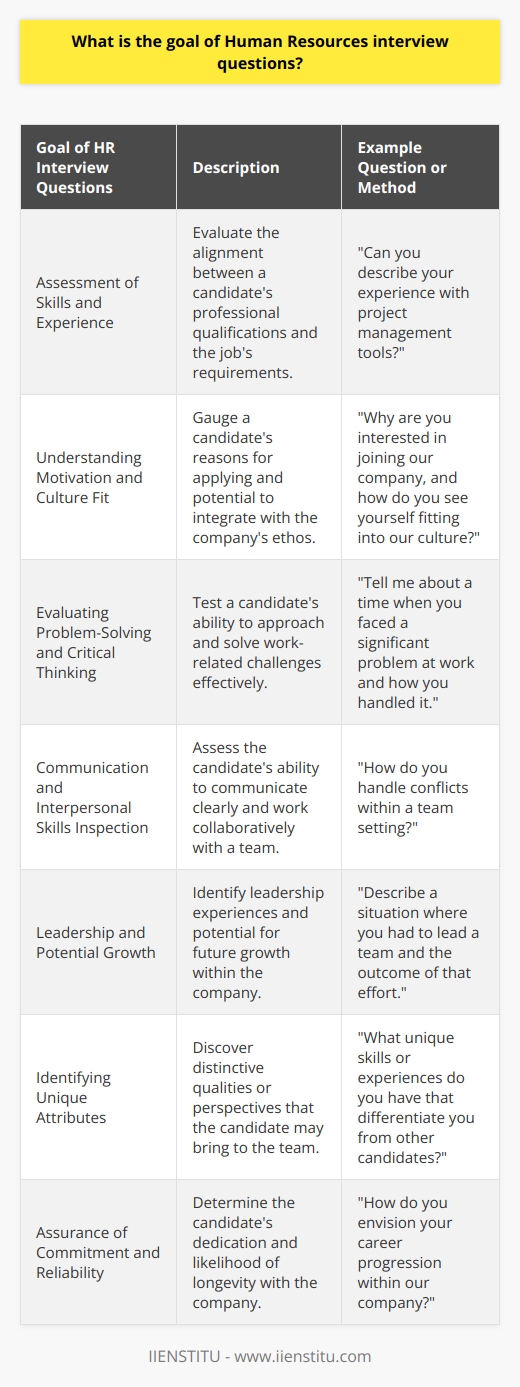
What are the most common HR interview questions?
Tell me about yourself.
What do you know about our company?
Why are you interested in working for us?
What are your strengths and weaknesses?
What motivates you?
How would your colleagues describe you?
What experience do you have in this field?
What have you done to improve your knowledge in the last year?
Describe a difficult work situation and how you overcame it.
What are your salary expectations?

How can I demonstrate my knowledge of HR policies and procedures in an interview?
You can demonstrate your knowledge of HR policies and procedures in an interview by giving examples of how you have applied them in previous roles or by discussing how you would approach a certain HR situation. You can also provide evidence of your understanding of HR policies and procedures by discussing how you would stay up to date on changes in the field or by describing how you have kept up with industry trends.

How can I demonstrate my ability to handle difficult personnel situations in an HR interview?
When answering this question, it is important to provide specific examples of how you have effectively handled difficult personnel situations in the past. Highlight the steps you took to identify the underlying issues, assess the situation objectively, and develop a plan of action to address the issue. Discuss the results of your efforts and how they impacted the organization. Be sure to also emphasize your communication, problem-solving, and conflict resolution skills.

What are the key elements of an effective human resource management strategy?
Key Elements of a Robust HRM Strategy
Employee Recruitment and Selection
An effective human resource management (HRM) strategy begins with the process of recruiting and selecting the right employees. This includes clearly defining job roles, responsibilities, and expectations, as well as utilizing relevant sources and tools to attract a diverse pool of qualified applicants. By conducting thorough interviews and assessments, the HRM team can identify candidates who align with the organization's goals and culture, ensuring a productive and engaged workforce.
Training and Development
Continuous investment in employee training and development is crucial for maintaining a high-performing team. A robust HRM strategy should facilitate the acquisition of new skills and knowledge, as well as encourage personal and professional growth. This may involve offering in-house training programs, sponsoring workshops and conferences, or partnering with external organizations for specialized expertise. When employees feel supported in their professional development, they are more likely to remain committed to the organization and contribute to its overall success.
Performance Management
Effective HRM strategies encompass the use of performance management systems that accurately assess employee performance and provide constructive feedback. Goals and key performance indicators (KPIs) should be regularly established and reviewed to ensure alignment with the organization's priorities. Additionally, the HRM team should work closely with management to address performance issues, facilitate open communication, and support employees in achieving their targets.
Employee Retention and Engagement
Retaining top talent is essential for organizational growth and stability. HRM strategies should incorporate policies and practices that promote employee satisfaction, such as competitive compensation, benefits packages, and a positive work environment. This may also involve fostering an inclusive and diverse culture, offering opportunities for advancement, and ensuring that employees feel valued and recognized for their contributions. Engaged employees are more likely to stay with the organization and contribute actively to its success.
Legal Compliance and Risk Management
Finally, an effective HRM strategy must consider legal compliance and risk management. Organizations need to ensure they are adhering to relevant employment laws, regulations, and industry guidelines to avoid potential legal disputes and costly penalties. HRM teams should be knowledgeable about current legal requirements and implement policies and procedures to minimize risks associated with employee relations, workplace safety, and data protection.
In conclusion, a comprehensive and effective HRM strategy should incorporate employee recruitment and selection, training and development, performance management, retention and engagement, and legal compliance and risk management. By addressing these essential elements, organizations can create a sustainable human resource foundation that drives success and fosters a thriving workplace culture.
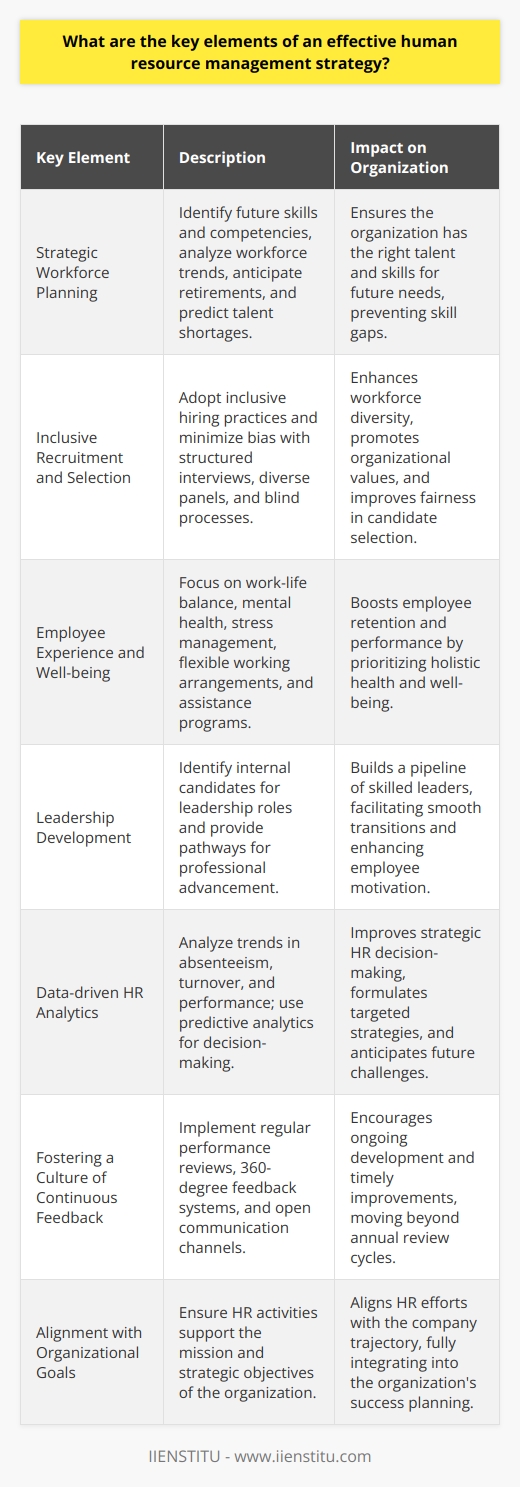
How can an organization ensure a fair and unbiased recruitment process?
Establishing a Transparent Recruitment Strategy
To ensure a fair and unbiased recruitment process, organizations must establish a transparent recruitment strategy. This includes setting clear selection criteria, developing standardized assessment tools, and engaging in systematic decision-making.
Defining Objective Criteria
The first step in promoting a fair recruitment process is defining objective criteria that will be used to evaluate candidates. These criteria should be based on the knowledge, skills, and abilities required for the role, as well as any specific qualifications or certifications needed. By clearly outlining these criteria, organizations can objectively assess applicants' fit for the position and minimize the potential for bias.
Standardizing Assessment Tools
In addition to establishing objective criteria, organizations should develop standardized assessment tools to evaluate candidates consistently. These tools can include structured interviews, aptitude tests, and role-specific tasks or simulations. Utilizing consistent assessment methods helps eliminate subjectivity and ensures that all candidates are assessed in the same manner, creating a level playing field for all applicants.
Diversifying Hiring Panels
Another technique to promote a fair and unbiased recruitment process is diversifying the hiring panel. Assembling a hiring team with varied experiences and perspectives can help minimize the impact of unconscious bias and contribute to a more equitable decision-making outcome. Moreover, providing training for panel members on unconscious bias and diversity-related issues can promote awareness and encourage inclusive hiring practices.
Documenting the Process
To maintain transparency and accountability throughout the recruitment process, organizations should document their procedures, assessments, and decision-making processes. Proper documentation allows for review and evaluation of the recruitment strategy itself and can help identify potential areas for improvement. Furthermore, accessible records enable organizations to demonstrate their commitment to fairness, equity, and transparency when needed.
Continuously Improving the Recruitment Process
Finally, organizations should continuously monitor and evaluate their recruitment process to identify opportunities for improvement. By gathering feedback from candidates and hiring team members, organizations can identify potential sources of bias or unfairness and make the necessary adjustments to maintain a fair and unbiased recruitment process.
In conclusion, an organization can ensure a fair and unbiased recruitment process by establishing a transparent strategy, defining objective criteria, standardizing assessment tools, diversifying hiring panels, documenting the process and continuously improving their methods. By adhering to these best practices, organizations can minimize the impact of unconscious bias and promote equitable hiring outcomes.
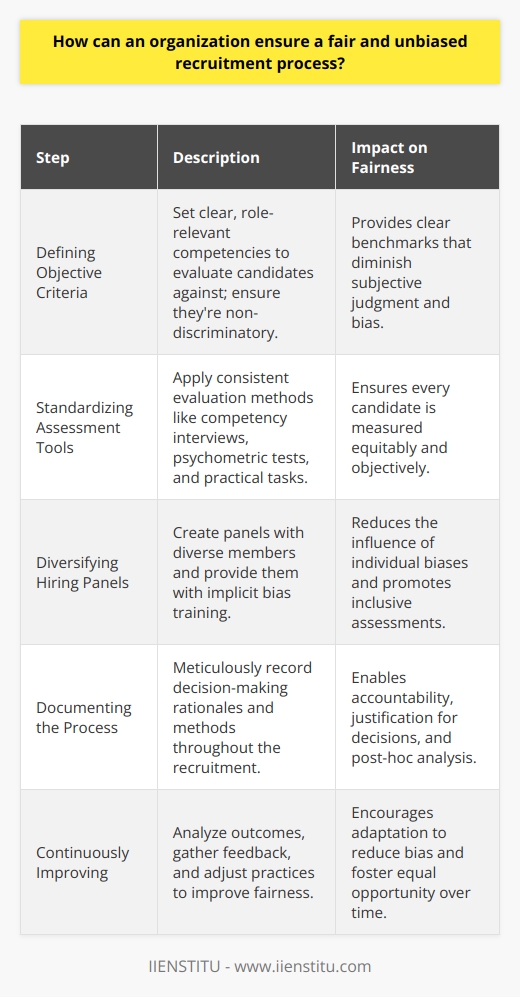
What role does employee engagement play in the overall success of an organization?
Role of Employee Engagement
Employee engagement is a critical driver in the overall success of an organization as it involves several aspects that contribute to a healthy and thriving work environment. A major role played by employee engagement is enhancing productivity. Engaged employees demonstrate higher levels of commitment and motivation, which in turn results in increased output and work efficiency.
Promotion of Loyalty and Retention
An engaged workforce is also likely to experience higher loyalty and retention rates. Engaged employees feel valued and recognized for their efforts, decreasing their likelihood of searching for other job opportunities. This ultimately reduces the costs related to hiring and training new employees and supports a stable workforce.
Cultivating a Positive Workplace Culture
Employee engagement fosters a positive workplace culture by promoting open communication and collaboration among team members. Engaged employees are more likely to share ideas, feedback, and knowledge with their colleagues, driving innovation and continuous improvement within the organization. A positive workplace culture further attracts and retains top talent, creating a competitive advantage.
Increased Customer Satisfaction
High levels of employee engagement have a direct correlation with customer satisfaction. When employees are motivated and committed to their roles, they are more likely to deliver quality services and products to customers. This creates a positive customer experience, enhancing brand loyalty and fostering repeat business.
Improved Financial Performance
Lastly, employee engagement has a significant impact on an organization's financial performance. Studies have shown a strong correlation between high levels of employee engagement and increased revenue, profitability, and shareholder return. Engaged employees are more likely to go the extra mile in their roles, contributing to the organization's overall success.
In conclusion, employee engagement plays a vital role in organizations by influencing productivity, loyalty and retention, workplace culture, customer satisfaction, and financial performance. By investing in employee engagement initiatives, businesses can cultivate a thriving and prosperous work environment that drives success at various levels.

What are the essential components of an effective performance management system?
Key Elements of Performance Management Systems
Goal Setting and Alignment
An effective performance management system begins with establishing clear and attainable goals that align with the organization's strategic objectives. Employees and managers should collaborate to identify performance expectations, set priorities, and develop action plans to achieve desired outcomes.
Continuous Feedback and Communication
Regular, ongoing feedback and communication between employees and managers ensure that expectations remain clear and issues can be addressed proactively. Constructive, two-way conversations encourage employees to take ownership of their performance and foster professional growth, while managers can provide timely support, guidance, and coaching.
Performance Evaluation and Assessment
Consistent, objective assessments of employee performance play a crucial role in identifying areas of improvement and recognizing achievements. Evaluating employees against pre-defined competencies, skills, and performance indicators ensures fairness and transparency in the process, while allowing for tailored development plans to close gaps and enhance performance.
Recognition and Reward
Acknowledging and rewarding employees for their accomplishments is vital to maintaining engagement and driving ongoing efforts towards meeting organizational goals. Effective performance management systems incorporate recognition and rewards that align with employee performance, motivation, and career aspirations, ensuring that they feel valued and inspired to excel in their roles.
Performance Improvement and Development
The primary purpose of a performance management system is to facilitate employee growth and continuous improvement. Accomplishing this involves identifying areas of improvement and providing the necessary resources, training opportunities, and targeted development plans. These initiatives empower employees to reach their full potential, contribute to the organization's success, and enhance their long-term career prospects.
Monitoring and Review
Lastly, effective performance management systems require ongoing monitoring and periodic review to ensure their implementation remains relevant, timely, and in line with organizational needs. Evaluating the system's effectiveness helps identify areas for improvement, rectify issues, and refine strategies to achieve greater success in managing and enhancing employee performance.
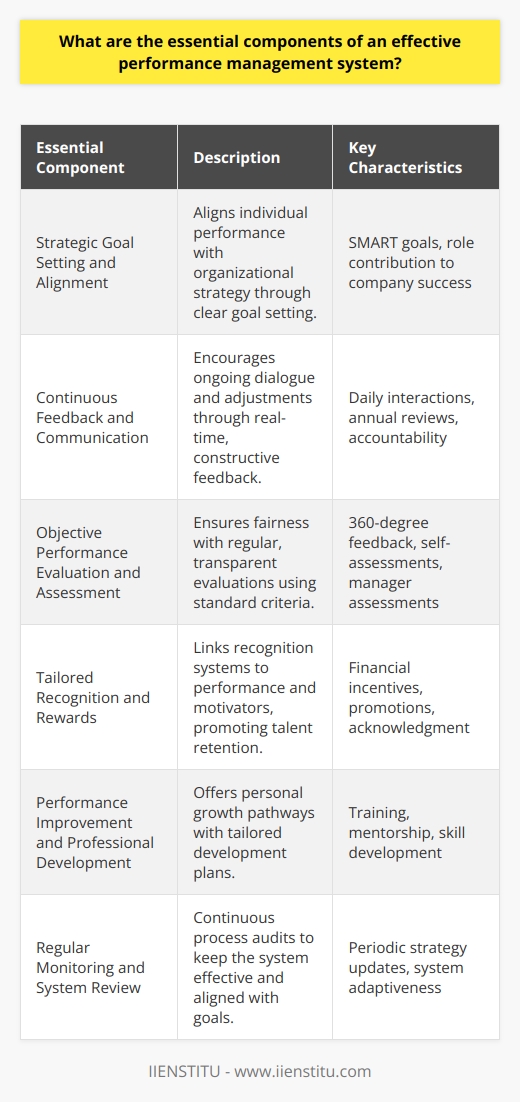
How can organizations promote diversity and inclusion in the workplace?
Organizations Promoting Diversity and Inclusion
Implementing Policies and Procedures
Organizations can promote diversity and inclusion in the workplace by implementing comprehensive policies and procedures that address both issues. These policies should clearly define expectations, set goals, and outline steps to achieve those goals. Employers must also ensure that they communicate these policies effectively to all employees and provide necessary training.
Offering Training and Educational Programmes
Providing continuous education and training opportunities for employees can foster a more inclusive environment, as they learn about different cultures, backgrounds, and perspectives. Offering workshops on unconscious bias, microaggressions, or cultural competency can help employees gain awareness and develop empathy, leading to a more inclusive and diverse work culture.
Recruiting with Diversity in Mind
To build a diverse workforce, organizations must intentionally incorporate diversity and inclusion at every stage of the recruitment process. This includes using diverse recruitment sources, promoting opportunities to underrepresented groups, and providing equal opportunities for all candidates. Employers should also consider implementing a blind recruitment technique to eliminate any unconscious bias.
Mentoring and Sponsorship Programs
Establishing mentoring and sponsorship programs enables employees from underrepresented backgrounds to receive guidance and support from experienced colleagues. This can help to build a more inclusive workplace, by empowering employees to grow professionally, develop new skills, and ultimately contribute to the overall diversity and success of the organization.
Celebrating Multiculturalism
Recognizing and celebrating the diverse cultures within an organization can foster a more inclusive atmosphere. Employers can organize events, such as heritage day celebrations or cultural awareness weeks, to showcase the different backgrounds present in the workplace, encouraging employees to learn and appreciate the unique contributions made by all individuals.
Monitoring Progress and Setting Goals
Continuously evaluating the company’s diversity and inclusion initiatives is essential to ensure effectiveness and identify areas for improvement. By regularly monitoring progress and setting goals, organizations can demonstrate their commitment to an inclusive environment, ultimately fostering a culture that values the unique perspectives and experiences of all employees.

What strategies can be implemented to reduce employee turnover and increase retention?
Subheading: Effective Hiring Process
One effective strategy to reduce employee turnover and increase retention is to implement a thorough and well-structured hiring process. This involves creating detailed job descriptions, conducting comprehensive interviews, and selecting candidates who align with the company's culture and values. By ensuring that new hires are a good fit for the organization, companies can reduce the risk of early departures and improve overall retention rates.
Subheading: Professional Development Opportunities
Another important strategy is offering professional development opportunities to employees. This can include ongoing training, skill-building workshops, and providing access to online courses or professional certifications. Providing employees with opportunities for growth and development not only helps them acquire new skills and expertise, but also demonstrates the company's commitment to their career progression. As a result, employees are more likely to stay loyal and engaged with the organization.
Subheading: Competitive Compensation Packages
Offering competitive compensation packages, including wages, bonuses, and benefits, is also essential in retaining employees. Companies should conduct regular salary reviews to ensure that their compensation is on par with industry standards and adjust wages accordingly. Furthermore, offering benefits such as comprehensive healthcare, retirement plans, and flexible work arrangements can help attract and retain top talent, leading to reduced turnover rates.
Subheading: Effective Communication Channels
Establishing open and effective communication channels between employees and management plays a crucial role in employee retention. This can involve regular performance reviews, anonymous feedback mechanisms, and fostering an environment in which employees feel comfortable voicing concerns or suggestions. Encouraging open communication can help identify potential issues early on, allowing management to address them before they escalate and lead to employee dissatisfaction and potential turnover.
Subheading: Recognizing and Rewarding Performance
Finally, recognizing and rewarding employee performance is a vital strategy in reducing turnover rates and increasing retention. Implementing performance-based incentives, celebrating employee achievements, and offering regular recognition for hard work can boost employee morale and motivation. Employees who feel valued and appreciated for their contributions are more likely to remain with the organization and continue to perform at a high level.
In conclusion, implementing strategies such as effective hiring processes, offering professional development opportunities, providing competitive compensation packages, establishing clear communication channels, and recognizing and rewarding performance can significantly contribute to reducing employee turnover and increasing retention. By investing in these strategies, companies can create a supportive and engaging work environment that encourages long-term loyalty and commitment from employees.
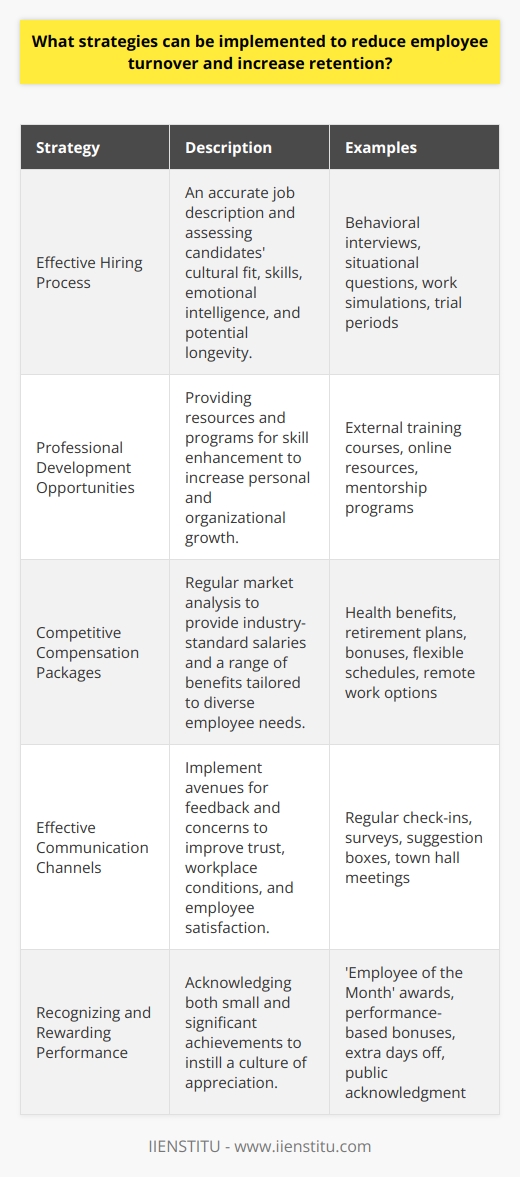
What are the critical factors to consider when developing a comprehensive employee training and development program?
Critical Factors in Program Development
When developing a comprehensive employee training and development program, it is crucial to consider several key factors that significantly impact the effectiveness and success of the program. Among these factors are organizational goals, employees' needs and learning styles, appropriate instructional methods, and evaluation techniques.
Aligning with Organizational Goals
The program should be aligned with the organization's primary objectives and strategic plans. This ensures that employees are receiving training relevant to their roles and responsibilities, which helps the organization reach its goals more efficiently.
Addressing Employees' Needs and Learning Styles
In order to maximize the learning experience, it is essential to consider the individual needs of the employees. This can be achieved by conducting a thorough needs assessment that helps identify skill gaps and address them through training and development activities. Moreover, it is vital to consider an individual's learning style and tailor the program to accommodate various preferences, such as visual, auditory, or kinesthetic learning.
Implementing Instructional Methods
The choice of instructional methods is critical in delivering the program effectively. Depending on the complexity of the subject matter and the employees' needs, different teaching methods may be employed. For instance, instructor-led training, e-learning, case studies, or on-the-job coaching can be employed. Employing a combination of methods is advisable to ensure employees remain engaged and are provided with various learning opportunities.
Evaluating Effectiveness
Lastly, continuously evaluating the program's effectiveness is crucial to ensure its success. This involves several stages: first, determining clear learning objectives and expected outcomes; second, measuring employees' performance before and after the training; and third, gathering employees' feedback about the program. This data will help make informed decisions for improvements and maximize the return on investment.
In summary, when developing a comprehensive employee training and development program, it is important to focus on alignment with organizational goals, addressing employees' diverse needs and learning styles, employing effective instructional methods, and continuously evaluating the program's effectiveness. Careful consideration of these critical factors will contribute to a successful and impactful program, ultimately fostering a skilled and competitive workforce.
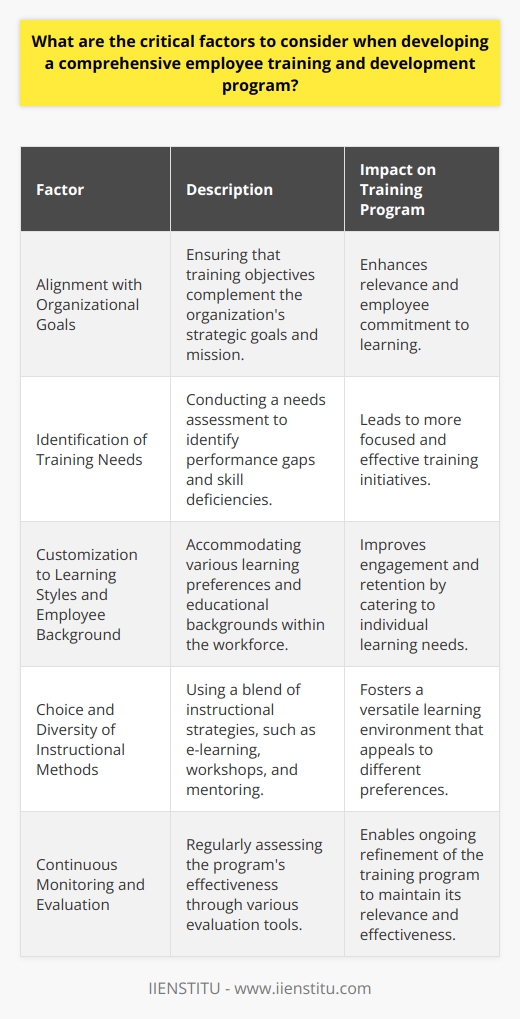
How can HR professionals effectively manage workplace conflicts and maintain a positive organizational culture?
Understanding the Root Cause of Conflicts
An effective way for HR professionals to manage workplace conflicts is through understanding the root cause of the disputes. Possible causes can include miscommunication, personality clashes, or dissatisfaction with company policies. By identifying the source of the issue, HR professionals can develop targeted interventions to address the problem and prevent its recurrence.
Promoting Open Communication
Another useful strategy for managing workplace conflicts involves promoting open communication among employees. HR professionals can encourage a culture of transparency by providing a platform for employees to voice their concerns, opinions, and grievances. This allows the organization to proactively address potential conflicts before they escalate and fosters a culture of trust and cooperation among team members.
Implementing Conflict Resolution Training
HR professionals can further enhance their ability to manage workplace conflicts by providing conflict resolution training to employees. This training can teach employees how to effectively communicate their concerns, negotiate solutions, and seek help from HR when necessary. Moreover, these skills can help employees form strong relationships, leading to a positive organizational culture.
Establishing a Fair and Consistent Policy
To maintain a supportive and positive organizational culture, HR professionals should establish a fair and consistent policy for addressing workplace conflicts. This policy should include clear guidelines for reporting conflicts, a timeline for resolving disputes, and consequences for engaging in unproductive or harmful behavior. By implementing and enforcing this policy, HR professionals can ensure that all employees feel valued and treated fairly, fostering a positive work environment.
Fostering a Climate of Collaboration
Establishing a climate of collaboration within the organization can also contribute to effective conflict management. HR professionals can facilitate team building activities and workshops that promote collaboration, cooperation, and collective problem-solving among employees. By nurturing a sense of camaraderie between team members, organizations are likely to see a decrease in conflicts and an increase in employee satisfaction.
In conclusion, HR professionals can effectively manage workplace conflicts and maintain a positive organizational culture by understanding the root cause of disputes, promoting open communication, implementing conflict resolution training, establishing a fair and consistent policy for addressing conflicts, and fostering a climate of collaboration. By adopting these strategies, organizations can create a supportive, productive, and harmonious work environment for all employees.
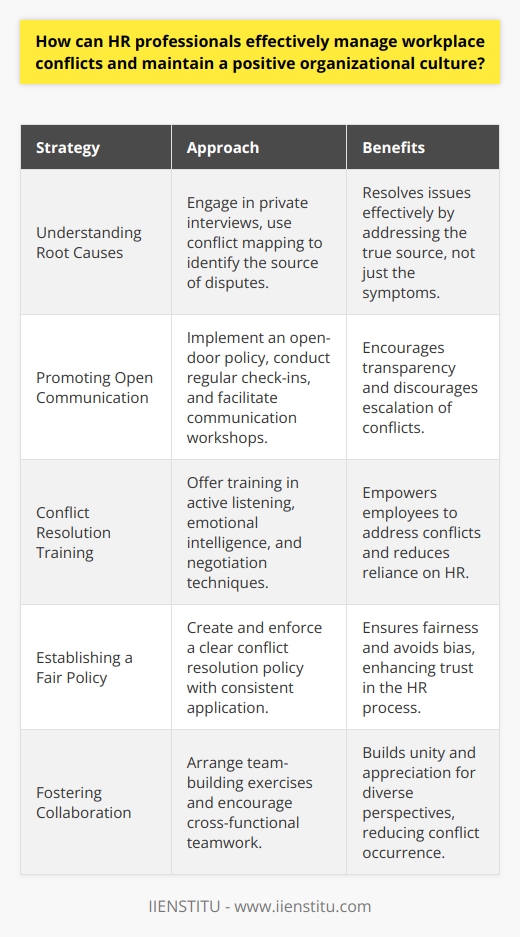
What role does HR analytics play in making informed decisions regarding talent acquisition, workforce planning, and employee retention?
Role of HR Analytics in Talent Acquisition
HR analytics plays a critical role in talent acquisition by providing data-driven insights that inform decision-making. It allows organizations to identify the most effective recruitment channels, assess candidate quality based on key performance indicators, and optimize the hiring process to decrease time-to-fill and cost-per-hire.
Workforce Planning through HR Analytics
In workforce planning, HR analytics facilitates a deeper understanding of workforce demographics, skill sets, and gaps, enabling organizations to make strategic decisions regarding staffing levels, resource allocation, and skill development. By leveraging data on employee performance, productivity, and capabilities, organizations can effectively align their talent with their business objectives and forecast workforce needs based on changing market conditions and industry trends.
Promoting Employee Retention with HR Analytics
Regarding employee retention, HR analytics can identify patterns and trends in employee behavior, such as turnover rates, job satisfaction, and engagement levels, which can help inform strategies to boost morale, enhance employee engagement, and reduce attrition. By analyzing various employee attributes, including work performance, tenure, and demographics, organizations can develop targeted retention initiatives aimed at specific employee segments. Moreover, tracking the effectiveness of these initiatives enables continuous improvement and better outcomes over time.
In conclusion, HR analytics is a valuable tool for organizations to make informed decisions about talent acquisition, workforce planning, and employee retention. By leveraging data-driven insights, organizations can optimize their talent management strategies, ensuring a more engaged, productive, and agile workforce that drives business success.

